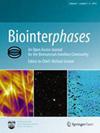钛碱化提高成骨细胞对唑来膦酸的反应。
IF 1.6
4区 医学
Q4 BIOPHYSICS
引用次数: 0
摘要
本研究旨在探讨氢氧化钠修饰钛表面对唑来膦酸(ZA)处理成骨细胞代谢的影响。采用机加工钛盘和氢氧化钠处理钛盘。通过扫描电镜、共聚焦显微镜和x射线光电子能谱(XPS)分析对表面进行了表征。将人成骨细胞植入椎间盘。24 h后,用5 μM的ZA处理细胞7 d。此时,评估细胞活力、胶原合成、总蛋白产量、碱性磷酸酶活性和矿物结节沉积。表面粗糙度结果进行描述性和统计学分析(t-Student), XPS结果进行定性描述。细胞代谢数据采用方差双向分析和Tukey检验,显著性水平为5%。结果表明,naoh处理增加了表面粗糙度(p < 0.05),并证实了钛酸钠和pH开关在naoh处理的磁盘上的存在。与植入机械圆盘的细胞相比,这种修饰还能提高成骨细胞的细胞活力、胶原合成、总蛋白产量和碱性磷酸酶(p < 0.05)。在ZA存在的情况下,两表面播种的细胞代谢和分化参数均显著降低(p < 0.05);然而,除矿物结节沉积外,植入修饰表面的细胞的这些参数值均较高(p < 0.05)。即使在ZA存在的情况下,NaOH修饰也能改善成骨细胞的粘附和代谢。NaOH溶液对钛的表面修饰可能是一种有趣的策略,可以改善成骨细胞的代谢和分化,加速骨整合过程,主要用于暴露于ZA的组织。本文章由计算机程序翻译,如有差异,请以英文原文为准。
Titanium alkalinization improves response of osteoblasts to zoledronic acid.
This investigation is aimed to determine the effect of the modification of titanium surface with NaOH on the metabolism of osteoblasts treated with zoledronic acid (ZA). Machined and NaOH-treated titanium disks were used. Surfaces were characterized by scanning electron microscopy, confocal microscopy, and x-ray photoelectron spectroscopy (XPS) analysis. Human osteoblasts were seeded onto the disks. After 24 h, cells were treated with ZA at 5 μM for 7 days. At this point, cell viability, collagen synthesis, total protein production, alkaline phosphatase activity, and mineral nodule deposition were assessed. The results of surface roughness were descriptively and statistically analyzed (t-Student), while the XPS results were qualitatively described. Cell metabolism data were analyzed by the analysis of variance two-way and Tukey tests at a 5% significance level. The results demonstrated that NaOH-treatment increased surface roughness (p < .05) and confirmed the presence of sodium titanate and a pH switch on the NaOH-treated disks. This modification also resulted in higher cell viability, collagen synthesis, total protein production, and alkaline phosphatase by osteoblasts when compared to cells seeded onto machined disks (p < 0.05). In the presence of ZA, all cellular metabolism and differentiation parameters were significantly reduced for cells seeded on both surfaces (p < 0.05); however, the cells seeded onto modified surfaces showed higher values for these parameters, except for mineral nodule deposition (p < 0.05). NaOH modification improved cell adhesion and metabolism of osteogenic cells even in the presence of ZA. The surface modification of titanium with NaOH solution may be an interesting strategy to improve metabolism and differentiation of osteoblasts and accelerate osseointegration process, mainly for tissues exposed to ZA.
求助全文
通过发布文献求助,成功后即可免费获取论文全文。
去求助
来源期刊

Biointerphases
生物-材料科学:生物材料
自引率
0.00%
发文量
35
期刊介绍:
Biointerphases emphasizes quantitative characterization of biomaterials and biological interfaces. As an interdisciplinary journal, a strong foundation of chemistry, physics, biology, engineering, theory, and/or modelling is incorporated into originated articles, reviews, and opinionated essays. In addition to regular submissions, the journal regularly features In Focus sections, targeted on specific topics and edited by experts in the field. Biointerphases is an international journal with excellence in scientific peer-review. Biointerphases is indexed in PubMed and the Science Citation Index (Clarivate Analytics). Accepted papers appear online immediately after proof processing and are uploaded to key citation sources daily. The journal is based on a mixed subscription and open-access model: Typically, authors can publish without any page charges but if the authors wish to publish open access, they can do so for a modest fee.
Topics include:
bio-surface modification
nano-bio interface
protein-surface interactions
cell-surface interactions
in vivo and in vitro systems
biofilms / biofouling
biosensors / biodiagnostics
bio on a chip
coatings
interface spectroscopy
biotribology / biorheology
molecular recognition
ambient diagnostic methods
interface modelling
adhesion phenomena.
 求助内容:
求助内容: 应助结果提醒方式:
应助结果提醒方式:


